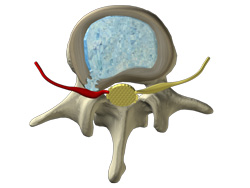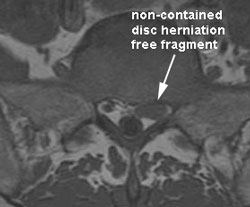About A Fort Wayne Non-Contained Disc Herniation


Non-contained discs (aka free fragment or extrusion) may be managed well conservatively. Non-contained lumbar disc herniations show better non-surgical relief than contained discs. (1) MRI helps in visualizing and monitoring the disc and nerve root changes while care is administered. (2) Nine of 11 non-contained discs shrunk 50% to 100% non-operatively. (3) Larger non-contained discs reduce the most. (4) Research notes spontaneous resorption of intradural disc material via macrophage and angiogenesis (the process of new blood vessels forming) within the disc. (5) As a matter of fact, free fragments (non-contained discs) absorb and decrease in size more than protruding (contained) discs. When the non-contained fragment moves, an even greater reduction in size is seen. (6) Phagocytes and cytokines play a role in helping resorb the non-contained disc. (7, 2)
A thorough, clinical examination that may include imaging is important to your recovery.
In-office, Cox Chiropractic Medicine Inc use Cox Technic Flexion Distraction and Decompression to lower the pressure in the disc and aid in the absorption of the free nuclear material that is irritating the nerve. Cox Technic also aids in the healing of the torn anular fibers and drives out chemicals that irritate and inflame the spinal nerves.
You must understand that it takes three months for a torn disc to heal well enough to allow you to return to daily activities like prolonged sitting, bending, lifting, twisting, etc. The first three to four weeks of concentrated treatment, therapies, and at-home care are designed to allow the best opportunity for the disc to heal quickly. This three month window does not mean that you must be treated continually throughout this time period, but means that you must be cautious and aware of your spine's healing. Recognize that even though the pain is gone, healing is still taking place and could be hindered if you do something to aggravate the process.
In the 1000 cases study of patients undergoing care for their back pain, 91% reported maximum improvement in 90 days of care and 70% of patients in less than 30 visits.
At home you will want to avoid sitting for long periods of time, wear a support brace if recommended, take nutritional supplements that help rebuild disc cartilage, sleep on a supportive mattress, sit in an ergonomically designed chair, avoid constipation which just forces you to use pressure that your spine doesn't need, and modify your daily activities as needed.
Exercise is important to your recovery and prevention of future pain.
It is important to start exercises as soon as possible, not vigorously, but gently.
Do only exercises recommended.
Do exercises only to your tolerance.
- Free Fragment: L5S1 Free Fragment
- Cox Technic Relieves Low Back and Leg Pain due to Two Discs - one extruded and one herniated
- Free Fragment: Free Fragment of Disc at L3-4 Relieved with Cox Technic
- Disc Extrusion Resorbed with Cox Technic Flexion Distraction System of Care
- L5 Radiculopathy from Large L4-5 Disc Extrusion Relieved
- 8.8mm Extrusion causes Low Back Pain, Leg Pain, Buttock Pain; Relief with Cox Technic
Contact Cox Chiropractic Medicine Inc for gentle, relieving care of your lumbar spine non-contained disc herniation.
- Cox, JM, Feller JA, Cox JA: Distraction Chiropractic Adjusting: Clinical Application, Treatment Algorithms, and Clinical Outcomes of 1000 Cases Studied. Topics in Clinical Chiropractic 1996; (3)3:45-59, 79-81
